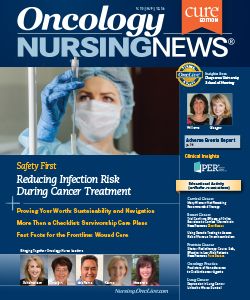Staph Infection From Infected Chemo Port: When the Nurse Becomes the Patient
A nurse relates her experience with breast cancer and the added stress of staph infection from a chemotherapy port.
Suzanne M. Kunze RN, CCM, MBA

Suzanne M. Kunze RN, CCM, MBA
In June 2016, I was diagnosed with stage II breast cancer with lymph node involvement. The treatment plan included lumpectomy, 4 cycles of chemotherapy over 12 weeks, radiation, and hormone therapy. It sounded reasonable and I thought it would be uneventful. I was wrong.
A port was placed and chemotherapy started the last week of July. I experienced high fever and chills on August 13th. I was instructed to call the oncologist if my fever went above 100.5. My fever went to 102 despite applying ice packs and taking acetaminophen every 4 hours. In the morning, I contacted the oncologist on call and was told to come to the emergency room for an evaluation.
I went to the ER where labs and blood cultures were drawn. Intravenous fluids and IV antibiotics were started. I was admitted to the hospital with the diagnosis of sepsis. The fever and chills continued. Blood cultures revealed a staph infection, and the port was infected. It was removed, and arrangements were made for PICC line placement on the day of discharge. The infectious disease doctor prescribed 6 weeks of IV antibiotics 3 times a day. I was taught to administer the antibiotics and discharged.
Having been in the hospital for 4 days, I was happy but scared to be going home. I have been a nurse for over 34 years; however, it is different when the nurse becomes the patient. I was completely overwhelmed by the responsibility of giving myself antibiotics.
The discharge planner arranged for home care. The infusion nurse came the day after discharge providing education and support. The nurses came weekly to change my PICC line dressing, draw labs, and review the antibiotic administration process. They reassured me that the PICC line site looked great and that I was administering the antibiotics correctly. This helped reduce the stress that I had been experiencing.
The antibiotics finished in late September, and the PICC line was removed after the last chemotherapy session October 7th, delayed by 1 week from the original plan. This infection complicated my treatment and added additional stress. Thankfully, that phase of the treatment is over.
To read about another nurse's experience as patient with a central line, click here.

Nurse Practitioners Weigh in on Data From the San Antonio Breast Cancer Symposium
January 16th 2023Loyda Braithwaite, MSN, RN, AGPCNP-BC, AOCNP; and Jamie Carroll, APRN, CNP, MSN, highlight presentations from the 2022 San Antonio Breast Cancer Symposium that will influence oncology nursing practice.



